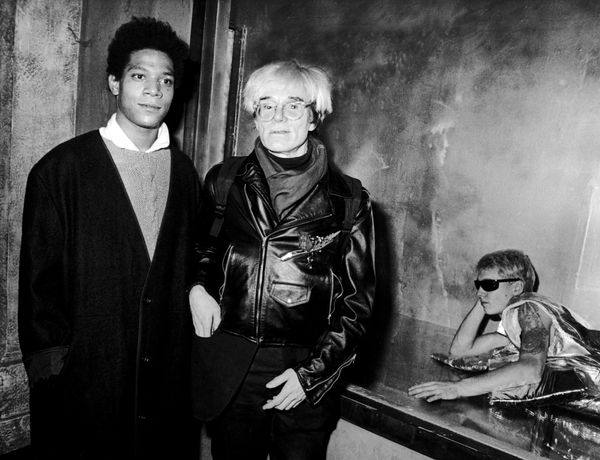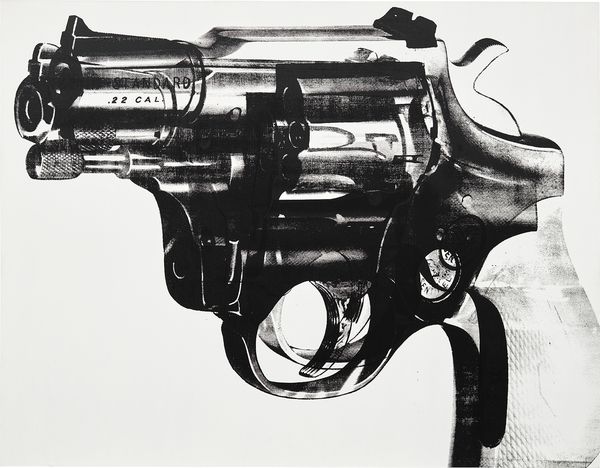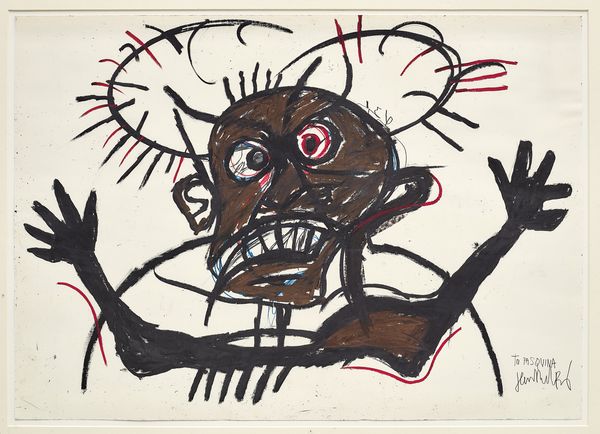Jean-Michel Basquiat and Andy Warhol, Area, New York, 1984 © Ron Galella/Contributor/Getty Images
Arnold Lehman: So we can start the beginning of how you first got involved with Andy Warhol.
Vincent Fremont: I had a fascination with Andy and his world and, by high school, I was totally a fan. I started freelancing for Andy in 1969 but left New York in January 1970 because the first lottery came up for the draft. I got out of the pre-induction physical but I didn't have any money so it took me roughly a year to get back to New York. By January of '71, Andy asked me to work full-time for $65 a week…I was probably 20. Andy gave me the keys to the studio — that's a lot of trust. He was very intuitive about people and it was an interesting time. In the early '70s, Andy's studio was in transition, the craziness of the Silver Factory was gone.
Andy Warhol Gun, 1981-1982. This work will be offered in our 20th Century & Contemporary Art Evening Sale in New York.
AL: Skipping ahead to 1980, '81, '82—Andy had already done the Shadows and been spending a lot of time with different kinds of objects that he was photographing—knives. And then in late 1980-1981, we come to these Guns. Did something lead up to the gun?
VF: It all happens very close together with his Knives. I don't know why he went from knives to guns—I think knives first and then guns. Here's a person who was almost killed by a gun. He's dealing with something that most people wouldn't want to if you've been shot by somebody with a gun. So he turns a life-threatening instrument into something of beauty. It pauses one to think about because a gun is violence. There's nothing else you can equate it with—a handgun. It's there to kill somebody.
It's dealing with American culture again because there's a certain level of violence attached to the imagery or potential violence — and again I'm only interpreting because Andy would never talk about this. He referenced things but he wouldn't really talk about it. But when you were walking down the street with him, or maybe during the afternoon, he'd get philosophical and you could get a little peeks into what he was thinking about.
So why did he want to take pictures of guns? We knew people who knew people who only had first names. So people brought in a sawed-off shotgun. I mean, serious. We didn't ask questions. Just take the pictures, take the guns out, and gone. Andy decides he doesn't want to use those, he goes to ads in the back of magazines, and that's where this Gun comes from. All the guns and gun paintings are not from the physical guns he took pictures of; they're from ad campaigns and whatever magazines, like gun magazines. He's going after the most common, easily accessible .22 calibers.
There's a lot of layering in the meaning and the fact that he almost died from somebody shooting him with a handgun. He's dealing with something — but I think the gun is a beautiful painting. They are a great series.
I think it’s this powerful image that causes people to stop and think. It's not unlike the electric chairs. It's still controversial. He takes something ominous and turns it into something beautiful at the same time, so you have that layer of terror.
AL: I know Andy didn't talk very much about the reasons that he was creating things. But do you remember anything about looking at the past, talking about Solanas, talking about being shot when he did these?
VF: For him to do Gun paintings, it was probably his way of dealing with that because it did affect him—he had to wear a corset for the rest of his life. His body was just riddled; that bullet ricocheted through just about every organ.
Like how everybody is an instant celebrity if you have a reality TV show. You don't even have to be interesting. And [Andy] saw that coming.
— Vincent Fremont
AL: Absolutely. Before we turn to Jean-Michel Basquiat, I just want to ask you one hypothetical question about the Gun. You knew him as well as anybody for a long time. What would you think his thoughts would be about all the gun violence in America today?
VF: It's hard for me to say. It is rare that I would speak in what Andy would think. There are times I can because I know exactly how he would approach certain issues. I think in this instance, he probably was a visionary and intuitive. I think he probably saw all this happening. Like how everybody is an instant celebrity if you have a reality TV show. You don't even have to be interesting. And he saw that coming. And I think with the guns he probably would have said something, it would have come out in his art. He would have dealt with it in some fashion but not preachy. He wasn't a judgmental person but it would show up, in photography or painting.

Jean-Michel Basquiat and Andy Warhol, Area, New York, 1984 © Ben Buchanan/Bridgeman Images
AL: I knew of Basquiat and Warhol’s relationship because of the exhibitions, and one time I was with them for quite some time when they were together. And Andy was trying to get Basquiat to talk to me. He said, "you know he's a museum director, maybe he could be helpful."
VF: You were at the Baltimore Museum at the time…
AL: And so how did they get started? Was that Bruno Bischofberger doing that?
VF: There are two people — or three but I'm not going into that — who said they introduced Andy officially to Jean-Michel. It's a combination of Bruno and Glenn. Because Glenn had the TV party, and you know Jean-Michel's SAMO appears on that show. Bruno already had his eyeball on him. That was late '70s early '80s. And he was doing these little postcards.
The chemistry between those two. Andy was attracted by people who were very eccentric, very crazy or had something really unusual about them: an unusual thought process—that intrigued him. Jean-Michel had charisma, talent and something more that attracted Andy to him: the way he was thinking, the way he interpreted how he painted. For Andy to embrace somebody this much...
AL: Especially because their work style, everything was totally contrary.
Jean-Michel Basquiat Untitled, 1982. This work will be offered in our 20th Century & Contemporary Art Evening Sale in New York.
VF: We did Andy's Warhol TV and by this time Andy was doing intros to the segments and we always got somebody to do it with him. There was one with Jean-Michel in it, and it's really good and you can see that Jean-Michel really likes Andy and vice versa. And it's one of the few times Andy gets physical, like putting his arm around somebody. I mean that meant something. Andy was not touchy-feely.
Their chemistry just worked. The fact that Andy would paint first when doing the collaboration, in a number of paintings you'll see that Jean-Michel obliterates pretty much everything that he's painting.
Jean-Michel learned a lot from Andy's techniques and how he got things done. Business and life.
— Vincent Fremont
AL: Just the trust of giving over a painting to somebody else to work on after he did it.
VF: They bonded incredibly well and they would go out at night with other people. There was Keith Haring, Kenny Scharf. Andy was very supportive at the same time of helping Jean-Michel make a sale.
Jean-Michel Basquiat Untitled, 1981. This work will be offered in our 20th Century & Contemporary Art Evening Sale in New York.
AL: What did Jean-Michel get from Andy?
VF: He knew he was a famous artist. The influence, the accouterments of being a famous artist—I think was very important. Andy was bigger than life. He was famous. It was a give and take. Andy was giving him counsel about a lot of stuff. They were having conversations. He was trying to get Jean-Michel off drugs—just work, paint. People don't understand that this was a really great moment in their lives. Andy appreciated it. It revitalized Andy. Jean-Michel learned a lot from Andy's techniques and how he got things done. Business and life.
Andy was like a mayor of New York in the art world sense. Andy was working, developing ideas and really thinking about stuff all the time. He was not lazy by any stretch. And I think Jean-Michel picked up on that. It looked easy to be Andy but it's not easy to be somebody like him. People like him do not come around often, at the right place and the right time and having the talent to back it up.
And Jean-Michel was another one who had the talent to back it up. And I think they saw that in each other. One was just much younger and Andy wanted to help Jean-Michel along.




